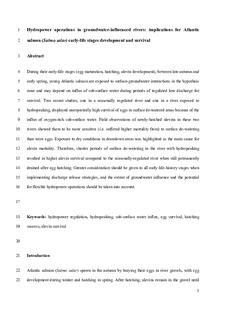Hydropower operations in groundwater-influenced rivers: implications for Atlantic salmon, Salmo salar, early life stage development and survival
Journal article, Peer reviewed
Accepted version
Permanent lenke
http://hdl.handle.net/11250/2481052Utgivelsesdato
2016Metadata
Vis full innførselSamlinger
Sammendrag
During their early life stages (egg maturation, hatching, alevin development), between late autumn and early spring, young Atlantic salmon are exposed to surface-groundwater interactions in the hyporheic zone and may depend on influx of subsurface water during periods of regulated low discharge for survival. Two studies, one in a seasonally regulated river and one in a river exposed to hydropeaking, displayed unexpectedly high survival of eggs in surface de-watered areas because of the influx of oxygen-rich subsurface water. Field observations of newly hatched alevins in these two rivers showed them to be more sensitive (i.e. suffered higher mortality from) to surface de-watering than were eggs. Exposure to dry conditions in drawdown areas was highlighted as the main cause for alevin mortality. Therefore, shorter periods of surface de-watering in the river with hydropeaking resulted in higher alevin survival than the seasonally regulated river when still permanently drained after egg hatching. Greater consideration should be given to all early life-history stages when implementing discharge release strategies, and the extent of groundwater influence and the potential for flexible hydropower operations should be taken into account.
